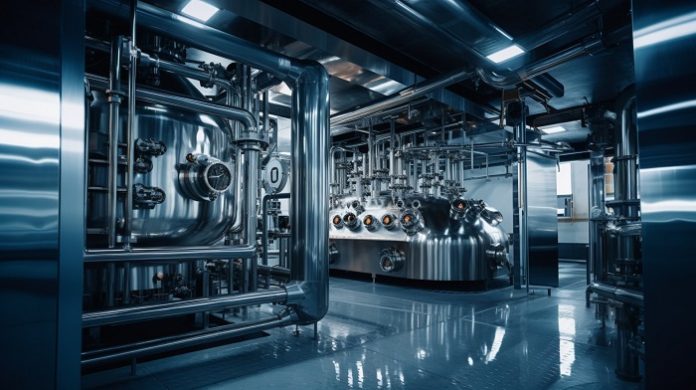The implementation of process-intensified equipment and methods in the chemical industry holds significant promise in addressing critical facets of energy, sustainability and decarbonisation. The recent Nobel Prizes highlight the remarkable impact AI is having on advancing scientific research. Adoption of AI will fundamentally reshape the PI landscape.
PI + AI
P rocess intensification (PI) refers to the development of technologies that can achieve the same or greater output from a given process using significantly less resources. This strategy is essential for reducing the environmental impact of the chemical industry and improving its energy efficiency.
Definition
The concept of PI has evolved significantly since its inception. While Ramshaw’s early definition in 1995 focused primarily on reducing plant size, subsequent definitions have expanded the scope to encompass a broader range of improvements, including energy efficiency, waste reduction, and overall sustainability. Stankiewicz and Moulijn’s seminal work in 2000 established a more comprehensive definition, emphasising the development of novel technologies that can dramatically improve manufacturing processes. Their later definition in 2002 further clarified the goal of process intensification as achieving a quantum leap in process and plant efficiency. Charpentier’s definition in 2005 highlighted the potential for process intensification to replace large, energy-intensive equipment with smaller, more efficient alternatives.
Process Intensification is a critical concept in modern process engineering that seeks to make industrial processes more efficient, compact, and sustainable. PI aims to reduce energy consumption, lower capital and operational costs, minimise waste, and shrink the physical footprint of processing plants, while enhancing the performance of chemical reactions and unit operations. As the world moves toward decarbonisation, PI becomes even more vital, helping industries optimise resource use and reduce emissions.
Paradigm Shift
The recent award of Physics and Chemistry Nobel Prizes to AI scientists, despite their lack of formal education in these fields, marks a significant paradigm shift in scientific research. This recognition underscores the growing influence of AI in driving scientific advancements across various disciplines, including the chemical industry. As AI continues to evolve, its applications in process intensification are expected to become increasingly prevalent. Traditional approaches to process intensification often involve the development of new catalysts, reactors, or separation techniques. While these methods have yielded significant improvements, they can be time-consuming and expensive. AI offers a more efficient and effective approach to process intensification by enabling researchers to explore a wider range of design possibilities and identify optimal solutions.
Artificial Intelligence (AI) can play an increasingly significant role in accelerating and enhancing PI. By harnessing AI-driven tools, engineers can design and implement intensified processes more effectively, reducing time and cost compared to traditional methods. AI’s ability to process complex datasets, simulate processes, and optimise variables in real time has opened new avenues for implementing PI in ways that were previously difficult or impossible. AI can identify optimisation opportunities, run complex simulations faster, and facilitate the implementation of intensified technologies. The convergence of AI and PI is particularly exciting because AI has the capacity to address many of the challenges that come with intensifying industrial processes.
Process Design
AI can be used to design intensified processes from scratch. By running simulations and modelling potential designs, AI can test various configurations of equipment and process layouts, predicting the performance of each without the need for costly physical trials. This allows engineers to experiment with novel designs, such as combining multiple unit operations into a single step, a key tenet of PI.
AI-powered tools like Computational Fluid Dynamics (CFD) and Process Simulation Software are instrumental in predicting the behaviour of fluids, solids, and gases in various process environments. When combined with AI, these tools become even more powerful, as AI can automate the simulation process, identify patterns, and suggest design changes that maximise process intensification.
Design Optimisation
Traditionally, process intensification involves trial-and-error methods, laboratory experiments, and simulations, all of which are time-consuming and costly. AI can dramatically accelerate this process by allowing engineers to base their designs on vast amounts of historical and real-time data. Machine learning algorithms can analyse the outcomes of various process configurations and conditions, identifying optimal parameters more efficiently than conventional methods.
AI-driven tools will make it possible to test hundreds or thousands of different configurations in virtual environments, such as through digital twins. These AI-enhanced simulations will not only predict how a process will perform but also suggest new ways to intensify it, such as by integrating multiple steps into a single operation or enhancing heat and mass transfer efficiencies. This data-driven approach will make it faster, cheaper, and more accurate to develop intensified processes.
Catalysis
Catalysis plays a key role in PI by speeding up chemical reactions, reducing energy consumption, and enabling processes to run under milder conditions. AI is revolutionising the design of catalysts, allowing scientists to discover and test new catalytic materials much faster than before.
Machine learning models can predict which combinations of materials will yield the best catalytic performance in intensified processes. AI can also help optimise the placement and structure of catalysts in reactors, ensuring that reactions proceed as efficiently as possible. This approach will drastically shorten the development cycle for catalysts and allow engineers to design processes that operate more sustainably and with less energy input.
Challenges
While AI holds immense potential, integrating it into process engineering comes with its own set of challenges. AI requires large amounts of high-quality data to function effectively. Many process industries operate with legacy equipment and fragmented data systems that may not be immediately compatible with AI. This means that significant investment is needed to upgrade infrastructure, collect accurate data, and ensure data security.
AI’s growing influence will require a shift in workforce skills. Process engineers will need to become proficient in working with AI tools, requiring new training programs and a shift in engineering curricula to include data science and machine learning.
As AI becomes more integrated into industrial processes, there are concerns about its environmental impact, especially in terms of energy consumption. AI systems, particularly those based on deep learning, require substantial computational power, which can contribute to increased carbon emissions if not powered by renewable energy sources.
Epilogue
PI principles align with several sustainability objectives outlined by the United Nations’ Sustainable Development Goals (SDGs) encompassing energy efficiency, waste reduction, resource conservation, emission reduction, circular economy principles and sustainable development. The adoption of AI will fundamentally reshape the PI landscape by enabling smarter, faster, and more sustainable process designs. AI-driven automation, optimisation, and innovation will make it possible to push the boundaries of what is achievable in terms of efficiency, resource use, and environmental impact. As industries embrace AI, the barriers to implementing PI at scale will diminish, ushering in a new era of process engineering that is not only more productive but also more sustainable and resilient in the face of global challenges like climate change. The convergence of AI and PI will define the future of industrial processes, making it possible to reconcile economic growth with environmental stewardship while accelerating the pace of technological innovation across sectors.
Readers’ responses may be sent to: k.sahasranaman@gmail.com or chemindigest@gmail.com

































